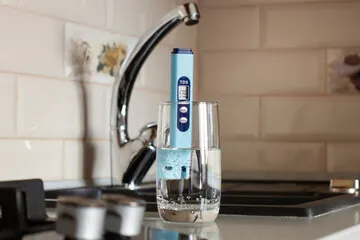What are TDS Levels in Water: What You Need to Know for Safe Consumption
Clean water is essential for good health and a good life. But with pollution and other issues, not all water is safe to drink. One way to check if water is safe is by looking at its TDS levels. Knowing what TDS levels are, why they matter, and how to keep them in check can help us all enjoy better water.
What Are TDS Levels in Water?

Definition of TDS
TDS stands for Total Dissolved Solids. It’s a measure of tiny particles dissolved in water. These particles include minerals, salts, metals, and other inorganic substances. They are so small that they stay in water even after filtering or boiling.
How TDS Is Measured
To find out the TDS level in water, you use a device called a TDS meter. These handheld gadgets give quick readings by passing an electric current through water. The readings show how many parts of solids are in each million parts of water. Common units include parts per million (ppm) or milligrams per liter (mg/L).
Sources of TDS in Water
TDS can come from many sources. Natural things like mineral deposits and groundwater add minerals to water over time. Human activities also add TDS, such as industrial waste, farming runoff, or water treatment processes. Both natural and man-made sources influence the overall TDS level.
Read More:
Coffee During Period Good or Bad?
Why TDS Levels Matter in Water Quality

Impact on Taste and Appearance
High TDS can change how water tastes. It may taste salty, bitter, or metallic. Water with high TDS might look cloudy or have an odd smell. This makes water less appealing and sometimes unrefreshing.
Health Effects
While some minerals in TDS can be good for health, too much can be harmful. Drinking water with very high TDS might cause stomach issues or other health problems. It can also lead to kidney problems if contaminated materials like heavy metals are present. That’s why regulations set acceptable limits for TDS content.
Effects on Plumbing and Appliances
Water with high TDS can clog pipes, reduce the lifespan of appliances, and make filtration systems work harder. Over time, high TDS causes buildup that costs money to repair or replace. It’s best to keep TDS levels in check to protect your plumbing and appliances.
What Are the Acceptable TDS Levels?

World Health Organization (WHO) Recommendations
The WHO suggests that TDS should be below 600 ppm for good taste and safety. They say that water with TDS over 1,000 ppm might start to taste salty or bitter. Levels below 300 ppm generally taste the best.
U.S. Environmental Protection Agency (EPA) Standards
The EPA allows up to 500 ppm of TDS in public water supplies. But this limit mostly focuses on taste and appearance, not health risks alone. If TDS is above certain levels, water might not be safe for drinking, even if it isn’t harmful directly.
Regional Differences
Different places have different standards based on local water sources. For example, some countries accept higher TDS levels because natural mineral water contains large amounts of dissolved solids. Always check local guidelines to know what’s safe in your area.
Read More:
What is the possible way to detox our body
How to Test and Keep Track of TDS Levels
DIY TDS Testing
You can buy a portable TDS meter at most hardware stores or online. It’s easy to use: just dip it into water, wait a few seconds, and read the number. Testing your water every few months helps catch problems early.
Professional Water Testing
If you suspect issues with your water, it’s better to get a lab analysis. Professionals can test for specific contaminants along with TDS, giving you a full picture of water quality. This is especially useful for well owners or industries.
Understanding the Results
TDS readings tell you if water is within safe limits. A high number might mean your water needs treatment. Low TDS usually indicates good water, but sometimes it also means lacking essential minerals. Balance is key.
How to Manage and Lower TDS
Water Filtration Options
- Reverse osmosis systems are the most effective. They push water through a filter that removes most solids.
- Distillation boils water, then condenses it back into liquid, removing impurities.
- Ion exchange filters swap unwanted minerals for safer ones, lowering TDS.
Tips for Maintaining Water Quality
- Regularly test your water.
- Clean filters and systems as recommended.
- Prevent pollution sources near your water supply.
- Use treatment solutions suited to your specific TDS level.
When to Seek Help
High TDS often happens with well water or in areas with poor water sources. In these cases, consulting a water treatment expert can save money and improve water safety. They can recommend the best filters or treatment plans based on your needs.
Real-World Examples and Lessons
Communities with High TDS
Some cities have naturally high TDS due to mineral-rich soil. Residents might notice taste issues or have to install special filters. Sometimes, high TDS is linked to health problems, prompting local officials to improve water treatment.
Reverse Osmosis in Homes
Many apartment complexes turn to reverse osmosis units to give residents clean water. This technology removes most dissolved solids, offering better taste and safety. It’s a good investment, especially if your water has high TDS.
Industrial Water Treatment Challenges
Factories often need to treat water with very high TDS to prevent damage to equipment. They use advanced filtration and chemical treatments. Learning from these cases helps us understand how complex managing TDS can be.
Conclusion
Monitoring TDS levels in your water matters more than most think. It affects taste, safety, and the life of your plumbing and appliances. Knowing the acceptable standards, how to test, and ways to reduce TDS ensures your water stays clean and healthy. Regular testing and proper treatment can keep your water safe and delicious for drinking, cooking, and cleaning.
Take action today—check your water’s TDS level and keep it within safe limits. Good water makes a healthier, happier life.






